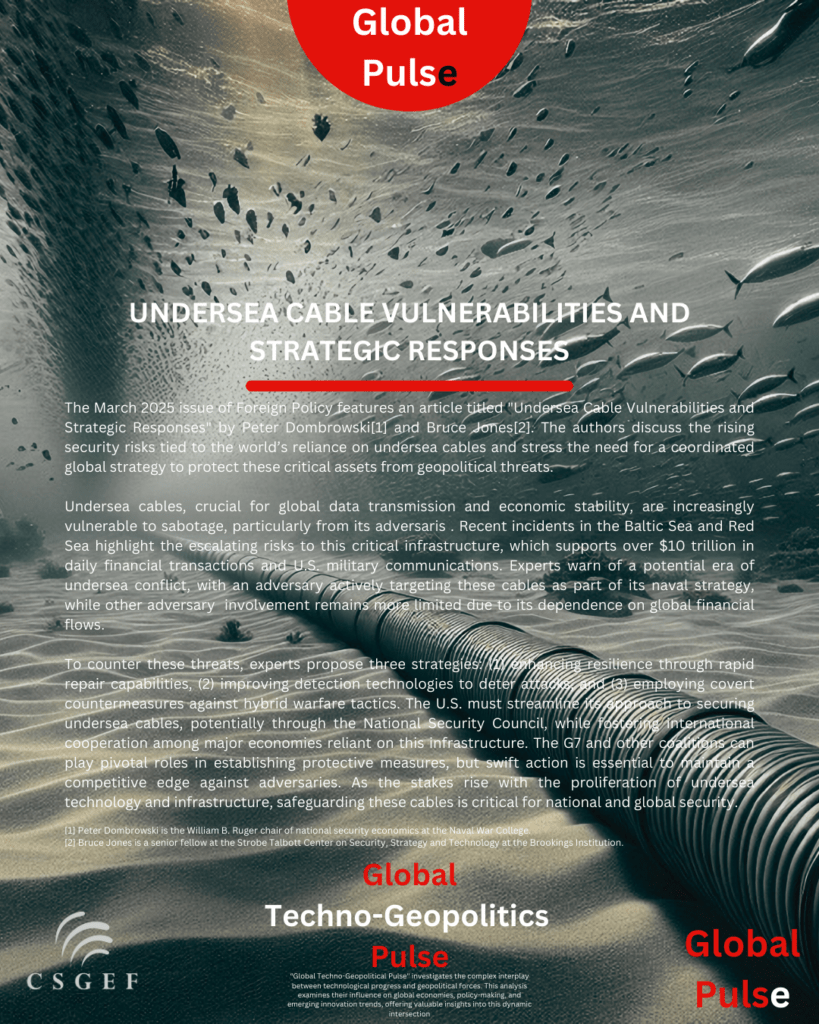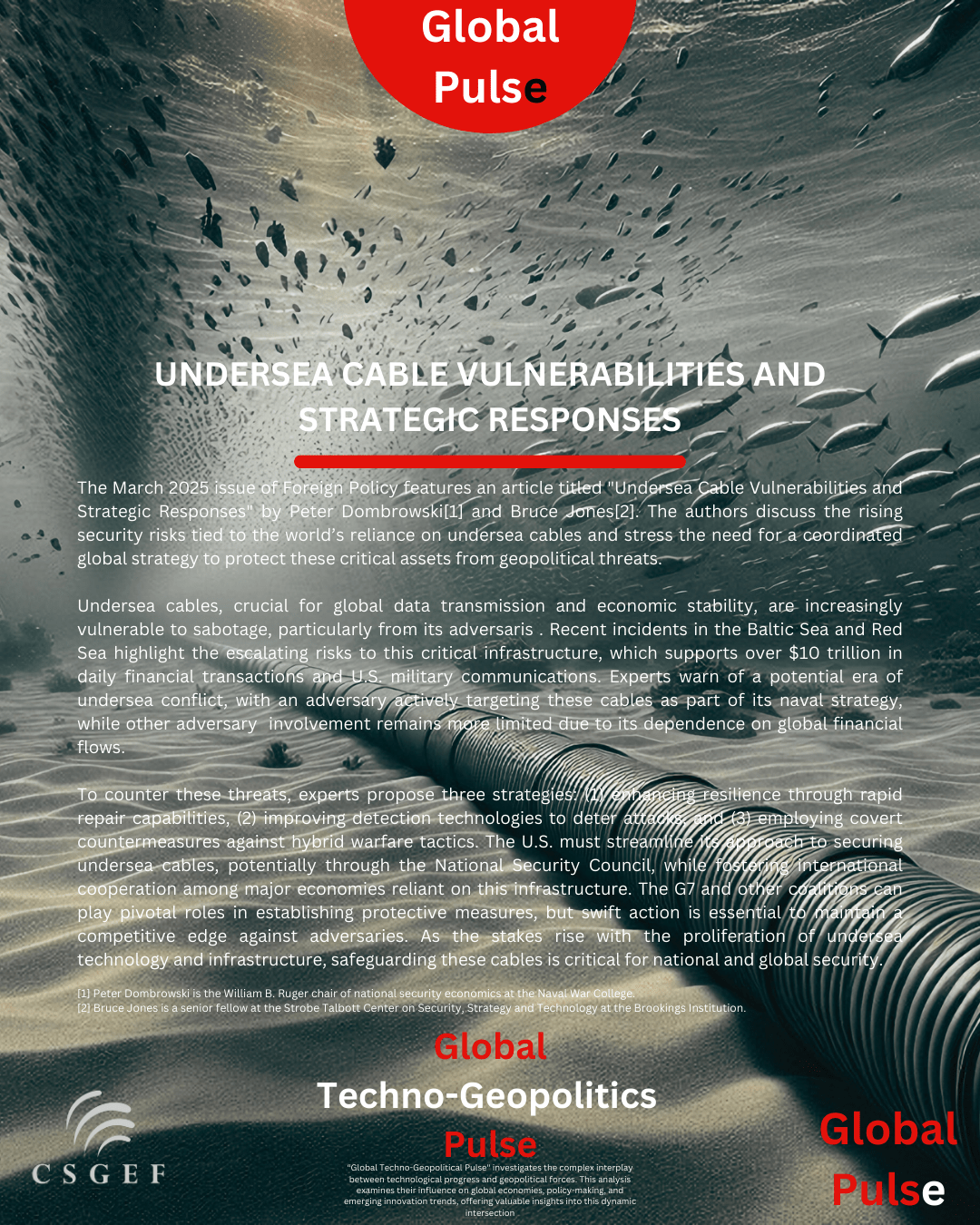Techno-Geopolitical
Explore how groundbreaking technology intersects geopolitical forces. This advanced analysis showcases how tech innovations influence global economies, policymaking, and innovation ecosystems.


Technology’s strategic role in geopolitics
· Impacts on policy and global markets
· Geostrategic implications of innovation
· Cybersecurity and Warfare
· Artificial Intelligence (AI) and Geopolitics:
· Space Geopolitics
· Biotechnology and its geopolitical implications
. Technological Innovation and Economic Competition
· Digital Infrastructure and Geopolitics
· Technological Dependence and Interdependence
· Technological Hegemony and Power
· Data Governance and Geopolitics
· Emerging technologies and geopolitics like quantum computing, nanotech, and 3D printing.


UNDERSEA CABLE VULNERABILITIES AND STRATEGIC RESPONSES
- 08/04/2025
- Global Pulse Editorial Team
The March 2025 issue of Foreign Policy features an article titled “Undersea Cable Vulnerabilities and Strategic Responses” by Peter Dombrowski[1] and Bruce Jones[2]. The authors discuss the rising security risks tied to the world’s reliance on undersea cables and stress the need for a coordinated global strategy to protect these critical assets from geopolitical threats.
Undersea cables, crucial for global data transmission and economic stability, are increasingly vulnerable to sabotage, particularly from Russia and China. Recent incidents in the Baltic Sea and Red Sea highlight the escalating risks to this critical infrastructure, which supports over $10 trillion in daily financial transactions and U.S. military communications. Experts warn of a potential era of undersea conflict, with Russia actively targeting these cables as part of its naval strategy, while China’s involvement remains more limited due to its reliance on global financial flows.
To counter these threats, experts propose three strategies: enhancing resilience through rapid repair capabilities, improving detection technologies to deter attacks, and employing covert countermeasures against hybrid warfare tactics. The U.S. must streamline its approach to securing undersea cables, potentially through the National Security Council, while fostering international cooperation among major economies reliant on this infrastructure.
The G7 and other coalitions can play pivotal roles in establishing protective measures, but swift action is essential to maintain a competitive edge against adversaries. As the stakes rise with the proliferation of undersea technology and infrastructure, safeguarding these cables is critical for national and global security.
Share:
Why Choose Global Pulse?
Global Pulse is your gateway to understanding the complexity of global developments.
About the Publication
In the 1st issue of Global Techno-Geopolitical Pulse – a supplement of Global Pulse at CSGEF- reviews an article in the March 2025 issue of Foreign Policy, which discusses the increasing security risks associated with the world’s reliance on undersea cables from USA adversaries. These cables are crucial for global data transmission and economic stability, supporting over $10 trillion in daily transactions and U.S. military communications. To counter these threats, experts propose three strategies: enhancing resilience through rapid repair capabilities, improving detection technologies, and employing covert countermeasures against hybrid warfare tactics.
- 08/04/2025
- Global Pulse Editorial Team
UNDERSEA CABLE VULNERABILITIES AND STRATEGIC RESPONSES

Global Techno-Geopolitical Pulse investigates the complex interplay between technological progress and geopolitical forces. This analysis examines their influence on global economies, policy-making, and emerging innovation trends, offering valuable insights into this dynamic intersection
The March 2025 issue of Foreign Policy features an article titled “Undersea Cable Vulnerabilities and Strategic Responses” by Peter Dombrowski[1] and Bruce Jones[2]. The authors discuss the rising security risks tied to the world’s reliance on undersea cables and stress the need for a coordinated global strategy to protect these critical assets from geopolitical threats.
Undersea cables, crucial for global data transmission and economic stability, are increasingly vulnerable to sabotage, particularly from Russia and China. Recent incidents in the Baltic Sea and Red Sea highlight the escalating risks to this critical infrastructure, which supports over $10 trillion in daily financial transactions and U.S. military communications. Experts warn of a potential era of undersea conflict, with Russia actively targeting these cables as part of its naval strategy, while China’s involvement remains more limited due to its reliance on global financial flows.
To counter these threats, experts propose three strategies: enhancing resilience through rapid repair capabilities, improving detection technologies to deter attacks, and employing covert countermeasures against hybrid warfare tactics. The U.S. must streamline its approach to securing undersea cables, potentially through the National Security Council, while fostering international cooperation among major economies reliant on this infrastructure.
The G7 and other coalitions can play pivotal roles in establishing protective measures, but swift action is essential to maintain a competitive edge against adversaries. As the stakes rise with the proliferation of undersea technology and infrastructure, safeguarding these cables is critical for national and global security.
In the 1st issue of Global Techno-Geopolitical Pulse – a supplement of Global Pulse at CSGEF- reviews an article in the March 2025 issue of Foreign Policy, which discusses the increasing security risks associated with the world’s reliance on undersea cables from USA adversaries. These cables are crucial for global data transmission and economic stability, supporting over $10 trillion in daily transactions and U.S. military communications. To counter these threats, experts propose three strategies: enhancing resilience through rapid repair capabilities, improving detection technologies, and employing covert countermeasures against hybrid warfare tactics.
© CSGEF All Rights Reserved

![shutterstock_1685194393-[Converted] shutterstock_1685194393-[Converted]](https://csgef.org/wp-content/uploads/elementor/thumbs/shutterstock_1685194393-Converted-r42ap2e1bw4hyl4v200vx3xg71i1ye3chsftct8jva.png)






